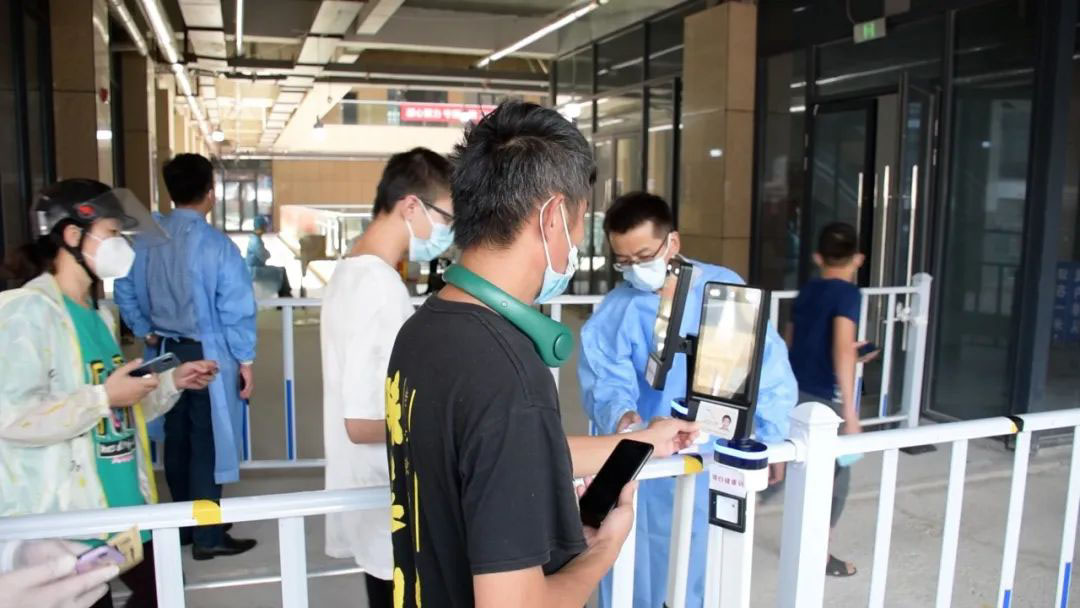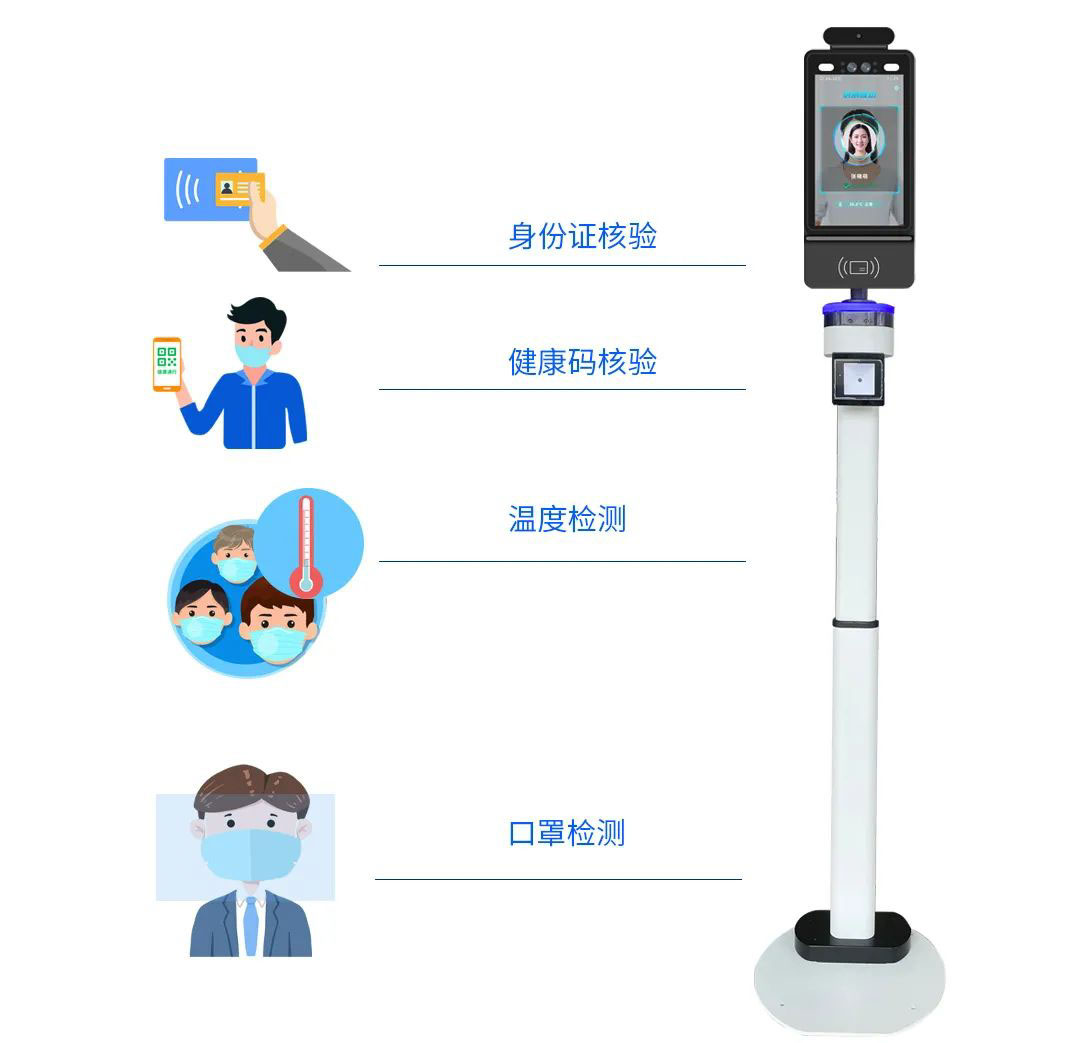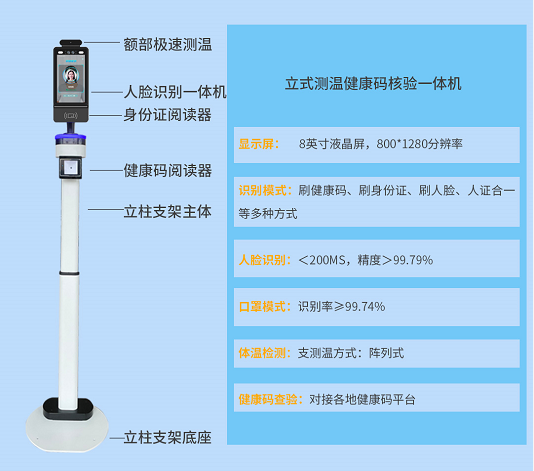The resurgence of the epidemic is causing the "Delta" to come unstoppably. Hospitals, as important places for the public to seek medical treatment and epidemic prevention and control, have high difficulty in daily management, high labor costs for prevention and control, and high risk of infection due to weak patients. Under the normalization of epidemic prevention and control, it is crucial to guard the safety gate of hospitals.
In the core area of the Nanjing epidemic prevention and control center, Jiangning District, Minivision has effectively reduced the cost of manpower investment and the risk of epidemic transmission during the verification process by implementing a "vertical temperature measurement and health code verification integrated machine" at multiple nucleic acid sampling points in Jiangning High tech Zone through technological epidemic prevention. This has improved the verification efficiency. At the same time, nearly a hundred tertiary hospitals and community hospitals both inside and outside the province are actively seeking innovation. Through a series of "hard core" technologies such as Minivision intelligent temperature measurement and health code verification and epidemic prevention systems, they have bid farewell to the traditional way of relying on manpower for long-term inspections, health code verification, and temperature measurement work, effectively reducing the risk of cross infection and providing better protection for medical staff and the public.

Since the outbreak of the epidemic in 2020, Minivision has gathered scientific research capabilities, fully leveraging its advantages in the field of artificial intelligence, and illuminating the path of fighting the epidemic with the light of technology.
As of now, nearly a hundred hospitals, medical institutions, and high-volume public places across the country have chosen to join forces with Minivision to fight the epidemic. The Minivision service area covers 13 cities throughout Jiangsu, serving over 30 hospitals, as well as tertiary and tertiary hospitals in multiple provinces such as Anhui, Guangdong, and Sichuan, serving a population of over 1 million. It has effectively safeguarded the lives and physical health of the people and has been highly recognized by hospitals.

Minivision's "hardcore" products help hospitals ensure the first level of prevention and control
Product core highlight: Minivision is based on facial recognition technology, and through front-end intelligent hardware and back-end service platform, it can achieve functions such as health code status verification, temperature insensitivity screening, person certificate integration authentication, automatic authorization of facial access control, entry and exit record tracing, data mining analysis, etc. It strengthens personnel access control in specific areas, saves labor costs, improves personnel management level, and enhances epidemic prevention and control effectiveness.

Hardware products:

Minivision Star Ring Platform:
The Minivision Star Ring platform supports optional modules such as mask recognition, ID card, temperature measurement, and health code verification; It can achieve unified platform management, unified data aggregation and analysis, real-time warning, and support public cloud and private deployment.

Installation method:
Support installation methods such as columns, gates, and wall hanging.

Classic Cooperation Cases of Hospitals
Nanjing Public Health and Medical Center
Nanjing Public Health and Medical Center is the largest infectious disease hospital in China. In January 2020, in the fight against COVID-19, Nanjing Public Health Medical Center, as a designated hospital, received all confirmed patients found in Nanjing.
Nanjing Children's Hospital
Nanjing Children's Hospital is a large-scale comprehensive tertiary A children's hospital that integrates medical treatment, scientific research, teaching, rehabilitation, and healthcare. The hospital has two hospital areas, Guangzhou Road Hospital and Hexi Hospital, with a total of 2027100 outpatient and emergency visits throughout the year.
Suzhou Industrial Park Xinghai Hospital
Suzhou Industrial Park Xinghai Hospital is the largest secondary comprehensive public hospital in Suzhou Industrial Park, integrating medical treatment, scientific research, teaching, and prevention. The hospital has an annual outpatient (emergency) diagnosis of 1.6 million people, 8000 inpatients, and 3000 surgeries.
Classic cooperation cases in Jiangsu Province also include: Nanjing Public Health Medical Center, Changzhou Third People's Hospital, Yangzhou Maternal and Child Health Hospital, Suzhou Wujiang District Children's Hospital, Xuzhou Stomatological Hospital, Xuzhou Mining Group General Hospital, Xuzhou Tumor Hospital, Pizhou Middle School Hospital, Taizhou Fourth People's Hospital, Taizhou Jiangyan Traditional Chinese Medicine Hospital, Yancheng Traditional Chinese Medicine Hospital, Suzhou Industrial Park Xinghai Hospital Jiangyan Qintong People's Hospital, Zhenjiang Runzhou District People's Hospital, Taizhou Jiangyan District Third Hospital, Fengxian People's Hospital, Peixian People's Hospital, Xuzhou Center for Disease Control and Prevention, and many other hospitals and medical institutions.
Wuhu Fanchang District People's Hospital
After more than 60 years of hard work and hard work, the People's Hospital of Fanchang District in Wuhu City has now developed into a modern second-class and first-class comprehensive hospital.
Chengdu Shuangliu District Traditional Chinese Medicine Hospital
Chengdu Shuangliu District Traditional Chinese Medicine Hospital was founded in 1956 and is a national tertiary and first-class traditional Chinese medicine hospital with an annual outpatient and emergency department of approximately 761700 people and approximately 20500 inpatients.
The Second Affiliated Hospital of Guangzhou Medical University
A large tertiary comprehensive hospital and affiliated hospital of higher medical colleges that integrates medical treatment, teaching, and scientific research, has become an important medical diagnosis and treatment, medical education, and medical research institution in Guangzhou, and a cadre health base in Guangzhou.















